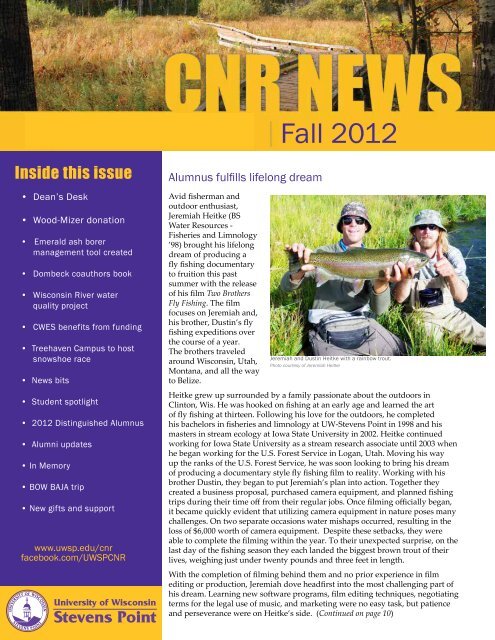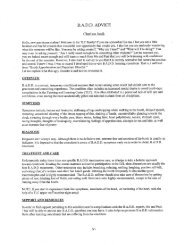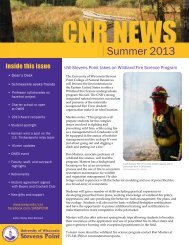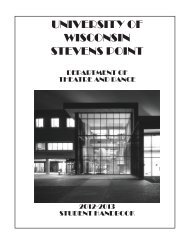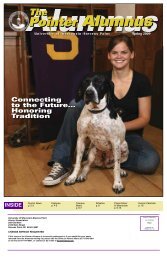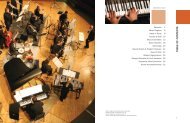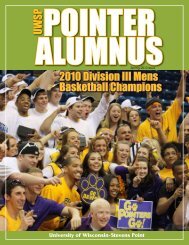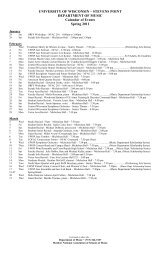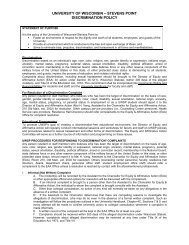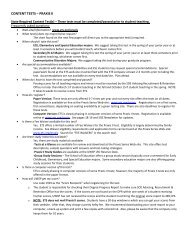UW-Stevens Point CNR Fall 2012 Newsletter .pdf - University of ...
UW-Stevens Point CNR Fall 2012 Newsletter .pdf - University of ...
UW-Stevens Point CNR Fall 2012 Newsletter .pdf - University of ...
Create successful ePaper yourself
Turn your PDF publications into a flip-book with our unique Google optimized e-Paper software.
Inside this issue<br />
• Dean’s Desk<br />
• Wood-Mizer donation<br />
• Emerald ash borer<br />
management tool created<br />
• Dombeck coauthors book<br />
• Wisconsin River water<br />
quality project<br />
• CWES benefits from funding<br />
• Treehaven Campus to host<br />
snowshoe race<br />
• News bits<br />
• Student spotlight<br />
• <strong>2012</strong> Distinguished Alumnus<br />
• Alumni updates<br />
• In Memory<br />
• BOW BAJA trip<br />
• New gifts and support<br />
www.uwsp.edu/cnr<br />
facebook.com/<strong>UW</strong>SP<strong>CNR</strong><br />
Alumnus fulfills lifelong dream<br />
Avid fisherman and<br />
outdoor enthusiast,<br />
Jeremiah Heitke (BS<br />
Water Resources -<br />
Fisheries and Limnology<br />
’98) brought his lifelong<br />
dream <strong>of</strong> producing a<br />
fly fishing documentary<br />
to fruition this past<br />
summer with the release<br />
<strong>of</strong> his film Two Brothers<br />
Fly Fishing. The film<br />
focuses on Jeremiah and,<br />
his brother, Dustin’s fly<br />
fishing expeditions over<br />
the course <strong>of</strong> a year.<br />
The brothers traveled<br />
around Wisconsin, Utah,<br />
Montana, and all the way<br />
to Belize.<br />
<strong>Fall</strong> <strong>2012</strong><br />
Jeremiah and Dustin Heitke with a rainbow trout.<br />
Photo courtesy <strong>of</strong> Jeremiah Heitke<br />
Heitke grew up surrounded by a family passionate about the outdoors in<br />
Clinton, Wis. He was hooked on fishing at an early age and learned the art<br />
<strong>of</strong> fly fishing at thirteen. Following his love for the outdoors, he completed<br />
his bachelors in fisheries and limnology at <strong>UW</strong>-<strong>Stevens</strong> <strong>Point</strong> in 1998 and his<br />
masters in stream ecology at Iowa State <strong>University</strong> in 2002. Heitke continued<br />
working for Iowa State <strong>University</strong> as a stream research associate until 2003 when<br />
he began working for the U.S. Forest Service in Logan, Utah. Moving his way<br />
up the ranks <strong>of</strong> the U.S. Forest Service, he was soon looking to bring his dream<br />
<strong>of</strong> producing a documentary style fly fishing film to reality. Working with his<br />
brother Dustin, they began to put Jeremiah’s plan into action. Together they<br />
created a business proposal, purchased camera equipment, and planned fishing<br />
trips during their time <strong>of</strong>f from their regular jobs. Once filming <strong>of</strong>ficially began,<br />
it became quickly evident that utilizing camera equipment in nature poses many<br />
challenges. On two separate occasions water mishaps occurred, resulting in the<br />
loss <strong>of</strong> $6,000 worth <strong>of</strong> camera equipment. Despite these setbacks, they were<br />
able to complete the filming within the year. To their unexpected surprise, on the<br />
last day <strong>of</strong> the fishing season they each landed the biggest brown trout <strong>of</strong> their<br />
lives, weighing just under twenty pounds and three feet in length.<br />
With the completion <strong>of</strong> filming behind them and no prior experience in film<br />
editing or production, Jeremiah dove headfirst into the most challenging part <strong>of</strong><br />
his dream. Learning new s<strong>of</strong>tware programs, film editing techniques, negotiating<br />
terms for the legal use <strong>of</strong> music, and marketing were no easy task, but patience<br />
and perseverance were on Heitke’s side. (Continued on page 10)
<strong>CNR</strong> News<br />
From the Dean’s Desk ...<br />
by Christine Thomas<br />
Dean Thomas with (left) Rowan Gould, Deputy Director, USFWS and (right) Jerome<br />
Ford, Assistant Director for Migratory Birds, USFWS.<br />
Photo courtesy <strong>of</strong> Garry Tucker, United States Fish and Wildlife Service<br />
This past year, I had the chance to be part <strong>of</strong><br />
an historic conservation event. In 2011, I was<br />
an alternate judge in the Federal Duck Stamp<br />
competition. This fall, I got to leave my training<br />
wheels behind and fly as a “real” judge. The<br />
event was held in Ogden, Utah, the last weekend<br />
in September. There were five judges, spanning a<br />
variety <strong>of</strong> expertise. You can only be a judge at this<br />
event once. This program is a wonderful melding <strong>of</strong><br />
art and science. The winning painting, chosen from<br />
192 entries, was a stunning common goldeneye by<br />
Robert Steiner <strong>of</strong> San Francisco, Calif.<br />
This event, which began in 1934, has identified the<br />
artwork that graces the Migratory Bird Hunting<br />
and Conservation Stamp. <strong>CNR</strong> alums all over the<br />
country will know duck stamps for many reasons.<br />
You may have purchased one for hunting migratory<br />
waterfowl. You may have won a framed print <strong>of</strong><br />
stamp art at a conservation banquet. You may have<br />
duck stamps in your stamp collection. Perhaps<br />
the best part is that many <strong>of</strong> you manage spectacular properties, made even more wonderful, by the addition <strong>of</strong> the 6<br />
million acres <strong>of</strong> waterfowl habitat that has been preserved on the landscape in the 80 years <strong>of</strong> the stamp program.<br />
In a time <strong>of</strong> great austerity and conservation challenges (Great Depression and Dust Bowl), our community came<br />
together and taxed ourselves and our activities to create a wildlife legacy for the future. The Federal Duck Stamp is<br />
but one example <strong>of</strong> that. This legacy continues today and every citizen <strong>of</strong> the world benefits from the conservation<br />
efforts that come from the proceeds. Just as every citizen <strong>of</strong> the world benefits from the many ways that <strong>CNR</strong> alums<br />
contribute to a sustainable future.<br />
Many thanks to the U.S. Fish and Wildlife Service and the Federal Duck Stamp program group for affording me the<br />
honor <strong>of</strong> participating in something so special. Thank you also to all <strong>of</strong> you for using the proceeds wisely to benefit all<br />
<strong>of</strong> us. I hope your fall has been filled with music <strong>of</strong> the waterfowl migration, the art <strong>of</strong> nature’s autumn canvas.<br />
Wood-Mizer sawmill donation<br />
Marv Kramer (BS Biology 62’) <strong>of</strong> Waupaca recently donated<br />
a Wood-Mizer sawmill to the college, which is already being<br />
incorporated into the forestry curriculum, including the college’s<br />
Wood Products Manufacturing course. Kramer and his wife, Sandy,<br />
are avid conservationists and longtime benefactors <strong>of</strong> the college.<br />
Marv, a Korean War veteran, completed his degree at <strong>UW</strong>-<strong>Stevens</strong><br />
<strong>Point</strong> and attended graduate school at <strong>UW</strong>-Madison. After working<br />
for three years as a field biologist for USDA and then as a science<br />
teacher in Monona Grove, he embarked on a long career in real<br />
estate development and sales. He retired in 1996 as CEO and<br />
chairman <strong>of</strong> Friendship Manor Homes, Inc. An avid hunter and<br />
fisher, he has been a member <strong>of</strong> Waupaca Conservation League,<br />
Whitetails Unlimited, Rocky Mountain Elk Foundation, and Safari<br />
Club International.<br />
2<br />
Marv Kramer and his dog Wylie with the donated Wood-Mizer.<br />
Photo courtesy <strong>of</strong> Steve Menzel
<strong>CNR</strong> News<br />
Emerald Ash Borer management tool created<br />
City foresters and arborists have a new tool to assist in management<br />
decisions related to the increasing presence <strong>of</strong> the invasive Emerald ash<br />
borer. Rich Hauer (BS Forestry ‘92), associate pr<strong>of</strong>essor <strong>of</strong> forestry, and<br />
Andrew VanNatta (BS Forestry ‘10), designed the Emerald Ash Borer<br />
(EAB) Planning Simulator to estimate the cost <strong>of</strong> managing ash trees over<br />
a 20 year span <strong>of</strong> an emerald ash borer infestation.<br />
Emerald ash borer larvae feed on the inner bark <strong>of</strong> ash trees, disrupting<br />
the trees ability to transport water and nutrients. The ash trees are<br />
generally killed within two to four years <strong>of</strong> the initial infestation. Since<br />
the invasive insects discovery in Michigan in 2002, they have claimed<br />
the lives <strong>of</strong> tens <strong>of</strong> millions <strong>of</strong> trees. Wisconsin ash trees have no known<br />
natural defense against these pests leading to the creation <strong>of</strong> various<br />
management options.<br />
The EAB Planning Simulator was designed based on ash forests on the<br />
<strong>UW</strong>-<strong>Stevens</strong> <strong>Point</strong> campus. Hauer and his students combined basic<br />
information about the campus forests, using tree evaluation s<strong>of</strong>tware<br />
programs from the U.S. Forest Service and the Council <strong>of</strong> Tree Landscape<br />
Appraisers. The model estimates the cost <strong>of</strong> managing the ash trees in<br />
four different ways: preemptive removal <strong>of</strong> all ash trees in the first five<br />
years <strong>of</strong> an infestation, removal and replanting with a different species,<br />
treatment with insecticides, and no action. Planners are able to see what<br />
the best option for their communities are, based on the management<br />
options that they are pursuing.<br />
Dombeck coauthors handbook for streamside owners<br />
Rich Hauer designed an emerald ash borer management tool.<br />
Photo courtesy <strong>of</strong> Stacey Bannach<br />
You can download the EAB model at http://cnrfiles.uwsp.edu/hauer/EAB-PLANSVersionBeta.xlsx.<br />
Mike Dombeck (BS Biology ‘74), pr<strong>of</strong>essor <strong>of</strong> global conservation,<br />
coauthored My Healthy Stream with Jack Williams, Trout Unlimited<br />
senior scientist, and Chris Wood, president and chief executive<br />
<strong>of</strong>ficer <strong>of</strong> Trout Unlimited. Produced as a partnership between<br />
Trout Unlimited and the Aldo Leopold Foundation, this handbook<br />
aims to provide people who own property bordering streams and<br />
rivers with information on caring for those waterways.<br />
Mike Dombeck oversaw the two largest federal land management<br />
agencies in the United States as chief <strong>of</strong> the U.S. Forest Service<br />
and director <strong>of</strong> the Bureau <strong>of</strong> Land Management. After retiring<br />
from the U.S. Forest Service, he became a <strong>UW</strong>-System Fellow and<br />
Pr<strong>of</strong>essor <strong>of</strong> Global Conservation at the <strong>University</strong> <strong>of</strong> Wisconsin-<br />
<strong>Stevens</strong> <strong>Point</strong>. He has served on the board <strong>of</strong> directors <strong>of</strong> many<br />
conservation groups, including the Aldo Leopold Foundation and<br />
Trout Unlimited. Dombeck currently resides along the Wisconsin<br />
River.<br />
The book may be purchased through the Aldo Leopold Foundation<br />
www.aldoleopold.org/books/.<br />
3
<strong>CNR</strong> News<br />
Wisconsin River water quality monitoring and improvement effort<br />
James Brodzeller, watershed research project assistant, collects water from<br />
the Wisconsin River for testing.<br />
Photo courtesy <strong>of</strong> the Center for Watershed Science and Education<br />
The <strong>UW</strong>-<strong>Stevens</strong> <strong>Point</strong> Center for Watershed Science and<br />
Education, and citizens and staff in Adams County, with the<br />
assistance <strong>of</strong> the Wisconsin Department <strong>of</strong> Natural Resources<br />
and the Army Corps <strong>of</strong> Engineers, are spearheading a nutrient<br />
pollution monitoring effort on the Wisconsin River between<br />
Tomahawk and Lake Wisconsin.<br />
The Wisconsin River flows through many communities and<br />
backyards on its 430 mile course to the Mississippi River. It<br />
begins its journey in Lac Vieux Desert through a forested and<br />
undeveloped landscape, as it continues south the dominant<br />
land use shifts from forest to agriculture. The increase in<br />
agricultural land use brings with it municipal and industrial<br />
storm water and wastewater discharges, and phosphorous<br />
rich soil run<strong>of</strong>f. The phosphorous, an element essential for<br />
algal and aquatic plant growth, accumulates downstream<br />
causing blue-green algae blooms in a number <strong>of</strong> reservoirs.<br />
The Petenwell and Castle Rock flowages, located in the<br />
monitoring area, are the second and fifth largest reservoirs in<br />
Wisconsin. These reservoirs have been experiencing excessive blue-green algae blooms, limiting the recreational<br />
use <strong>of</strong> the waterways and causing a public health concern. The Department <strong>of</strong> Health services has documented<br />
numerous cases <strong>of</strong> exposure to blue-green algae resulting in respiratory ailments, rashes, and on rare occasions<br />
death. The information collected during the monitoring effort will help determine where land management efforts<br />
and funding can be targeted to aid in decreasing the nutrient levels in the waterways that cause blue-green algae<br />
blooms.<br />
A symposium is held each year providing an opportunity for citizens, representatives from municipalities,<br />
industry, stewardship groups, agencies, educators, agricultural producers, and legislators to learn about the<br />
monitoring effort, define what the Wisconsin River means to communities along its banks, and show what is<br />
currently being done to protect or improve conditions in the river and its tributaries. This year’s symposium<br />
Hearing the River, Hearing Each Other, will be held on the <strong>UW</strong>-<strong>Stevens</strong> <strong>Point</strong> campus on March 28, 2013.<br />
Learn more about the Wisconsin River Water Quality Improvement project and register for this year’s symposium<br />
at www.uwsp.edu/cnr-ap/watershed/Pages/ImproveProject.aspx<br />
4<br />
Petenwell flowage boat landing covered with algae.<br />
Photo courtesy <strong>of</strong> the Center for Watershed Science and Education
<strong>CNR</strong> News<br />
CWES benefits from funding awarded to the <strong>UW</strong>-<strong>Stevens</strong> <strong>Point</strong> Foundation<br />
Linda Gruber joined the Central Wisconsin Environmental<br />
Station (CWES) this summer to assist in the coordination<br />
<strong>of</strong> a new summer camp focused after school program for<br />
upper-elementary school students in the Amherst, Rosholt,<br />
and Iola school districts as well as the Portage County<br />
Boys and Girls Clubs. The after-school activities include<br />
programs on pond study, fishing, stars and stories, survival<br />
skills, critters at camp, crafts, and campfire songs and skits.<br />
Students who attend a majority <strong>of</strong> the monthly activities<br />
will be eligible to apply for partial scholarships for a week<br />
<strong>of</strong> CWES summer camp in 2013. Scholarship recipients will<br />
be announced in the spring.<br />
A student from the Plover Boys and Girls Club shows the<br />
aquatic insect she collected.<br />
Photo courtesy <strong>of</strong> Linda Gruber<br />
Gruber’s position<br />
and these<br />
programs are<br />
possible in part<br />
because <strong>of</strong> a<br />
grant from the<br />
Students from Jefferson Elementary School search for aquatic insects.<br />
Photo courtesy <strong>of</strong> Linda Gruber<br />
Margaret A. Cargill Foundation. The <strong>UW</strong>-<strong>Stevens</strong> <strong>Point</strong> Foundation was<br />
awarded the three-year grant totaling $225,000 to increase the number <strong>of</strong><br />
children attending CWES summer camps and supporting the training <strong>of</strong><br />
future educators and camp leaders. The Margaret A. Cargill Foundation<br />
supports environmental education, including camping programs that allow<br />
young people to interact with nature and develop a sense <strong>of</strong> environmental<br />
stewardship.<br />
Located in Amherst Junction on the shore <strong>of</strong> Sunset Lake, CWES hosts an<br />
average <strong>of</strong> 7,500 people each year for summer camps, school programs,<br />
youth and adult team building and leadership skills programs, youth<br />
retreats, church gatherings, family reunions, and other events.<br />
Learn more about CWES at www.uwsp.edu/cwes.<br />
Treehaven to host second annual snowshoe race<br />
The “Treehaven Tromp,” a 5k and 10k snowshoe fun run and race, will be held February 9,<br />
2013, at Treehaven in Tomahawk, Wis.<br />
The snowshoe race is part <strong>of</strong> the Braveheart Snowshoe Racing Series and a <strong>2012</strong>-2013 United<br />
States Snowshoe Association Regional Qualifying Event. A free chili lunch will be provided<br />
to all participants and race t-shirts will be available for purchase.<br />
For registration information, visit www.uwsp.edu/treehaven.<br />
5
<strong>CNR</strong> News<br />
News bits<br />
Dennis Yockers, Wisconsin’s Project WILD<br />
Facilitator <strong>of</strong> the Year.<br />
New Faculty and Staff<br />
• Rebecca Franzen- Assistant Pr<strong>of</strong>essor <strong>of</strong> HDNR<br />
• Audrey Gaedtke - Treehaven Campus Office Manager<br />
• Linda Gruber - Educator at CWES<br />
• Kendra Liddicoat - Assistant Pr<strong>of</strong>essor <strong>of</strong> HDNR<br />
6<br />
Yockers named Wisconsin’s Project WILD Facilitator <strong>of</strong> the Year<br />
Dennis Yockers, retired pr<strong>of</strong>essor <strong>of</strong> human dimensions <strong>of</strong> natural resource<br />
management, was named the <strong>2012</strong> Wisconsin Project WILD Facilitator <strong>of</strong> the<br />
Year. Project WILD is a wildlife-focused conservation education program for K-12<br />
educators and their students. Yockers was Wisconsin’s first state coordinator. With<br />
help from an assistant he conducted over fifty workshops the first year. Yockers<br />
continued his commitment to Project WILD through his entire career.<br />
Schmeeckle Reserve has record turnout at Candlelight Hike<br />
Festival<br />
Schmeeckle Reserve’s Candlelight Hike Festival continues to attract growing<br />
numbers <strong>of</strong> community members and students. More than 900 people joined the<br />
fall celebration on November 2, which featured the nighttime sky. The festival<br />
includes trails lit by jack-o’-lanterns, discovery stations, crafts, and a character<br />
interpretation program presented by students in the Environmental Education/<br />
Interpretation Practicum.<br />
Navigating Environmental Attitudes: Lessons from Wolves<br />
In an effort to better understand environmental attitudes, Tom Heberlein,<br />
pr<strong>of</strong>essor emeritus at the <strong>University</strong> <strong>of</strong> Wisconsin-Madison and a<br />
visiting pr<strong>of</strong>essor at the Swedish <strong>University</strong> <strong>of</strong> Agricultural Sciences,<br />
discussed his studies <strong>of</strong> attitudes toward wolves in the Midwest and in<br />
Sweden on Wednesday, November 7, at 5 p.m. in the Laird Room <strong>of</strong> the<br />
Dreyfus <strong>University</strong> Center. Heberlein shared how attitudes have been<br />
responsible for the stunning success <strong>of</strong> wolf restoration and identified the<br />
possibilities for a negative shift in attitudes toward wolves in the future.<br />
Hansen receives AFS 2011 best paper<br />
Michael Hansen, pr<strong>of</strong>essor <strong>of</strong> fisheries and commissioner, was honored<br />
with the best paper for 2011 in the North American Journal <strong>of</strong> Fisheries<br />
Management from the American Fisheries Society (AFS). Hansen received the award at the annual AFS meeting<br />
in August. The paper is titled Natural mortality in relation to age and fishing mortality on walleyes in Escanaba Lake,<br />
Wisconsin, during 1956-2009.<br />
• Ron Masters - Assoc. Pr<strong>of</strong>essor <strong>of</strong> Wildlife Fire Science<br />
• Kristy Seblonka - <strong>University</strong> Associate in CLUE<br />
• Jake Smith - Budget and Finance Specialist<br />
A complete list <strong>of</strong> all <strong>CNR</strong> faculty and staff can be found at www.uwsp.edu/cnr/pages/facultyDirectory
<strong>CNR</strong> News<br />
Student spotlight - Brandy Anderson<br />
Brandy Anderson is a senior majoring in wildlife ecology with<br />
a minor in captive wildlife management. She is originally from<br />
Rockford, Ill. but moved to Milwaukee, Wis. during high school.<br />
She loves the challenge <strong>of</strong> new experiences and is definitely<br />
getting her fill, on campus and across the nation. She is involved<br />
with the following student groups on campus: Herpetology<br />
Society, Animal Behavior Club, Save the Frogs, Minorities in<br />
Agriculture, Natural Resources and Related Sciences, and the<br />
Wildlife Society.<br />
Anderson has participated in the Field Biology <strong>of</strong> the Pacific<br />
Coast and Great Basin trip, New York City Neighborhoods<br />
Geography trip, and will be participating in a trip to South Africa<br />
with Eric Anderson, wildlife pr<strong>of</strong>essor, in January.<br />
She shared some <strong>of</strong> her experiences at <strong>UW</strong>-<strong>Stevens</strong> <strong>Point</strong> and her<br />
future plans with us.<br />
What brought you to <strong>UW</strong>-<strong>Stevens</strong> <strong>Point</strong>?<br />
“I originally had an interest in TV production, starting out<br />
at Brown College and then switching to Milwaukee Area<br />
Technical College. I soon realized my lifelong love <strong>of</strong> animals<br />
and heard about <strong>UW</strong>-<strong>Stevens</strong> <strong>Point</strong> from a friend. I was really<br />
interested in all <strong>of</strong> the different student organizations but the clincher was the fact that there was a Herpetology<br />
Society.”<br />
Brandy Anderson worked with ring tailed lemurs at the<br />
Tanganyika Wildilfe Park.<br />
Photo courtesy <strong>of</strong> Brandy Anderson<br />
Wildlife ecology major Brandy Anderson holds a turtle.<br />
Photo courtesy <strong>of</strong> Brandy Anderson<br />
What was your favorite <strong>UW</strong>-<strong>Stevens</strong> <strong>Point</strong> moment?<br />
“I have enjoyed all <strong>of</strong> the traveling experiences and getting to know<br />
new people. I also participated in an internship last summer at<br />
Tanganyika Wildlife Park in Goddard, Kan. I had the opportunity to<br />
work with all aspects <strong>of</strong> the zoo but my favorite part was working<br />
with the ambassador animals. I walked the ambassador animals<br />
around the park sharing information with guests and giving them an<br />
opportunity to interact with each <strong>of</strong> the animals.”<br />
What are your plans after graduation?<br />
“I want to work in an interactive zoo or wildlife park, a place where<br />
I get to work with the daily care <strong>of</strong> the captive wildlife but also get<br />
to ambassador some <strong>of</strong> the animals around or give behind the scenes<br />
tours. I believe the more the public knows and interacts with an<br />
animal the more open they are to conservation.”<br />
7
<strong>CNR</strong> News<br />
Alumni updates<br />
Chancellor Patterson presented the <strong>2012</strong> <strong>UW</strong>-<strong>Stevens</strong> <strong>Point</strong> Distinguished Alumnus<br />
Award to Paul DeLong.<br />
Photo courtesy <strong>of</strong> Doug Moore<br />
Jacob Becken receives “Newcomer <strong>of</strong> the<br />
Year” award.<br />
Photo courtesy <strong>of</strong> Wisconsin Wastewater Operators<br />
Association, Inc.<br />
Jacob Becken (BS Soil<br />
and Waste Resources<br />
‘12) was awarded the<br />
Wisconsin Wastewater<br />
Operators Association<br />
“Newcomer <strong>of</strong> the Year”<br />
award because <strong>of</strong> his<br />
exceptional enthusiasm<br />
and willingness to learn.<br />
Becken currently works<br />
for the Green Bay Metro<br />
Sewerage District.<br />
Mark Mueller (BS<br />
Resource Management<br />
‘66) Spooner, Wis. is the founder, president and chief<br />
technology <strong>of</strong>ficer <strong>of</strong> Botanic Innovations, LLC., and<br />
Curieum Healthcare Holdings, Inc. companies. The<br />
company produces and sells high valued botanical<br />
ingredients for use in skin care and wellness products.<br />
Their company is developing an immunotherapy cancer<br />
drug which is currently being tested in a human clinical<br />
trial at the <strong>University</strong> <strong>of</strong> Minnesota Masonic Cancer<br />
Center. Mark and others in the company have been<br />
awarded a patent from the U.S. Patent Office for the<br />
smart drug which targets tumors and enables the bodies<br />
immune system to eradicate cancer. The safe and non<br />
toxic drug is in the vanguard <strong>of</strong> new approaches to super<br />
charge the bodies immune system to fight cancer.<br />
Louise Venne (BS Wildlife ‘03) Gainesville, Fla.<br />
8<br />
<strong>UW</strong>-<strong>Stevens</strong> <strong>Point</strong> Distinguished Alumnus<br />
Paul DeLong (BS Forest Administration ‘85) is the first<br />
<strong>UW</strong>-<strong>Stevens</strong> <strong>Point</strong> alumnus to head the Wisconsin<br />
Department <strong>of</strong> Natural Resources Division <strong>of</strong> Forestry,<br />
a position he has held since 2003. Many fellow alumni<br />
are members <strong>of</strong> his team, which he says is a result<br />
<strong>of</strong> their applied training and experience rather than<br />
deliberate selection.<br />
Among his accomplishments is certifying more than<br />
five million acres <strong>of</strong> forestland and working with<br />
countless partners to protect and sustain the state’s<br />
forests. He also returns to his alma mater from time<br />
to time to share his expertise as a member <strong>of</strong> the <strong>CNR</strong><br />
Forestry Advisory Committee. You can learn more<br />
about DeLong on the <strong>UW</strong>-<strong>Stevens</strong> <strong>Point</strong> YouTube<br />
Channel www.youtube.com/user/<strong>UW</strong><strong>Stevens</strong><strong>Point</strong>.<br />
successfully completed her PhD at the <strong>University</strong> <strong>of</strong><br />
Florida Department <strong>of</strong> Wildlife<br />
Ecology and Conservation. Her<br />
research focused on how wading<br />
birds respond to prescribed fires<br />
in<br />
the Everglades.<br />
Frank Thomas (BS Natural<br />
Resources ‘67), Detroit Lakes,<br />
Minn., retired on June 30 after<br />
teaching in the Minnesota<br />
Detroit Lakes Independent<br />
School District since September<br />
Louise Venne<br />
Photo courtesy <strong>of</strong> Louise Venne<br />
<strong>of</strong> 1976. The late Dr. Wievel had a great impact on his<br />
career, telling Thomas’ class not to be picky on their<br />
first employment. Thomas’ first employment was with<br />
the U.S. Army. With Weivel’s advice fresh in his mind,<br />
when asked where he would like to be stationed he<br />
listed anywhere. The sergeant in charge thought he was<br />
kidding and put him down for Germany because <strong>of</strong> his<br />
German language experience in high school. In May 1968<br />
he reported to Massweiler, Germany, as a radio teletype<br />
operator.<br />
Dave Neu (BS Wildlife Ecology ‘84) Madison,<br />
Wis., became the program director for the Leopold<br />
Conservation Award-Sand County Foundation in<br />
January. Neu previously worked for the WDNR, the<br />
National Wild Turkey Federation, and the<br />
Minnesota DNR.<br />
We love to hear what our alumni have been up to!<br />
Share your stories with us via email at cnr@uwsp.edu.
<strong>CNR</strong> News<br />
In Memory<br />
Allan Skinner (BS Conservation ‘59) passed away on<br />
September 29, <strong>2012</strong>. Allan was born on August 16, 1936,<br />
near Suring, Wis. to Russell and Helen Skinner and was<br />
raised in Oregon, Wis.<br />
Skinner began a federal career shortly after his<br />
graduation from <strong>UW</strong>-<strong>Stevens</strong> <strong>Point</strong>. He was recently<br />
presented with a certificate for 50 years <strong>of</strong> federal<br />
service, 38 <strong>of</strong> which have been with the U.S. Army Corps<br />
<strong>of</strong> Engineers (USACE) Alaska District. He spent time<br />
working as a park ranger for the National Park Service<br />
in several places, including Theodore Roosevelt National<br />
Park, Yellowstone National Park, Lake Mead National<br />
Recreation Area, and Death Valley. He also worked as a<br />
USACE park ranger in California and Indiana.<br />
He enjoyed hunting, fishing, and trapping in earlier<br />
years, and telling stories <strong>of</strong> such in his later years. He<br />
liked listening to classic country music, telling stories,<br />
road trips, reading publications from all across the states,<br />
listening to weekend and nightly radio programs, and<br />
being with friends. Allan most enjoyed sharing stories<br />
amongst his friends.<br />
Mariah Peterson<br />
Photo courtesy <strong>of</strong> Nancy Peterson<br />
Allan Skinner receives a certificate for 50 years <strong>of</strong> federal service.<br />
Photo by Curt Biberdorf<br />
Mariah Peterson (BS Water Resources ‘81) passed away on November 5,<br />
2011. She loved sports, nature, and the outdoors. She led a life filled with<br />
travel and adventure working on sea lamprey research in Michigan’s<br />
upper peninsula, doing salmon research on Kodiak Island in Alaska,<br />
touring Peru, back country skiing, mountain biking, and wilderness<br />
canoeing, just to name a few.<br />
After graduating from <strong>UW</strong>-<strong>Stevens</strong> <strong>Point</strong>, Anderson completed a master’s<br />
in fish biology and human anatomy from Mon. State <strong>University</strong> in 1984<br />
in Bozeman, Montana. Mariah loved living in Montana because <strong>of</strong> the<br />
numerous opportunities to hike, bike, canoe, fish, kayak, and ski. After<br />
an injury to her back she found that chiropractic methods and T’ai Chi<br />
helped ease the pain and this started her on the path <strong>of</strong> healing and being<br />
a healer. She gained status as a T’ai Chi master, winning competitions,<br />
and ran her own Shen Yi School <strong>of</strong> T’ai Chi in Portland for several years.<br />
She also taught and did research at Oregon College <strong>of</strong> Oriental Medicine.<br />
Her continued desire to be a healer brought her to complete a master’s in<br />
physical therapy at the <strong>University</strong> <strong>of</strong> Montana in Missoula. She continued<br />
to practice physical therapy in Minocqua and Appleton until she moved to<br />
Seneca <strong>Fall</strong>s, N.Y., to pursue a master’s degree in acupuncture.<br />
9
<strong>CNR</strong> News<br />
BOW trip to the Sea <strong>of</strong> Cortez and Mexico’s Baja Peninsula<br />
BOW participant with a sea lion at Los Islotes.<br />
Photo courtesy <strong>of</strong> Becoming an Outdoors Woman<br />
Alumnus fulfills lifelong dream (continued from cover page)<br />
Six months into the editing phase, a hard drive crash caused all <strong>of</strong> his hard work to<br />
disappear in a matter <strong>of</strong> minutes. This was a disappointing stumbling block, but one<br />
that was small in comparison to the process <strong>of</strong> negotiating the licenses for the music.<br />
After a year and a half <strong>of</strong> continual contact with the various music agencies, his efforts<br />
paid <strong>of</strong>f with a sound track including songs by Wilco, Cake, G Love & Special Sauce,<br />
Ziggy Marley, and Third World.<br />
The completed film was better than they envisioned. Looking to bring something<br />
different to the world <strong>of</strong> fly fishing documentaries, they focused their efforts on<br />
minimizing dialogue and allowed the footage to speak for itself. The film highlights<br />
numerous species including bonefish, tarpon, kokanee salmon, and a 4 ½ foot sturgeon.<br />
Two Brothers Fly Fishing is now available on Amazon.<br />
Heitke currently works as the lead fish biologist with a consulting firm in Boise, Idaho,<br />
and looks forward to producing future films under his fly fishing media company,<br />
Heron Fly Fishing.<br />
10<br />
The Becoming an Outdoors-Woman (BOW) program is headed<br />
to the Sea <strong>of</strong> Cortez and Mexico’s Baja Peninsula. This trip is part<br />
<strong>of</strong> a series <strong>of</strong> specialty events to unique ecosystems called “BOW<br />
Destinations.”<br />
The Baja BOW is designed for women <strong>of</strong> all ages, experience<br />
levels, and backgrounds. The all-inclusive trip (excludes airfare)<br />
<strong>of</strong>fers 8 sun-filled days and 7 starry nights <strong>of</strong> outdoor experiences<br />
for $2,250. The adventure begins with a stay at La Duna Eco-<br />
Farm where participants will learn about the desert community<br />
surrounded by mountains.<br />
After the ranch stay and whale watching at Magdalena Bay, the<br />
group will travel to an island camp, Isla Partida, which has been<br />
has been designated a World Heritage Site – a world class natural<br />
park. Activities for the next 4 days include hiking, snorkeling, and<br />
kayaking.<br />
During the program, participants will become comfortable with<br />
snorkeling and kayaking through personalized instruction,<br />
proper gear fitting, and education about the surrounding<br />
environment. This will prepare the group for the highlight <strong>of</strong> the<br />
trip – snorkeling with a colony <strong>of</strong> 400 wild sea lions at Los Islotes.<br />
Participants will be treated to a 5 star camp. Each tent is equipped with two comfortable cots, sleeping bags, linens, bath<br />
towels, and a night stand. Other amenities include: flush toilets, solar showers with private stalls, beach lounge chairs<br />
and umbrellas, purified water, soda, c<strong>of</strong>fee, an honor bar for adult beverages and a chef plus 3-person crew to prepare<br />
delicious meals and tend the camp.<br />
This 3rd annual Baja BOW is <strong>of</strong>fered in partnership with Green Edventures, an insured, U.S.-based company founded<br />
and run by <strong>CNR</strong> alumna Tara Short (BS Resource Management/Environmental Ed ’02). Tara has a decade <strong>of</strong> experience<br />
leading high school students and adults to remote places in Alaska, the Bahamas, and Mexico.<br />
For more information on the Baja BOW, visit the BOW website at www.uwsp.edu/cnr-ap/BOW. Check out video <strong>of</strong><br />
the 2011 Baja BOW group on www.youtube.com; search for “women’s island adventure La Paz” to access a link to the<br />
video.<br />
Two Brothers Fly Fishing Cover<br />
Photo courtesy <strong>of</strong> Jeremiah Heitke
<strong>CNR</strong> News<br />
Highlights <strong>of</strong> new gifts and support<br />
• Veolia Environmental Services (Wisconsin Rapids/Chicago) – $10,000 ($5,000 to provide Veolia<br />
Environmental Services scholarships for five students in spring <strong>2012</strong>; and $5,000 to support the <strong>CNR</strong><br />
Special Projects Fund).<br />
• James & Joann Bernd (Waupaca, Wis.) $5,000 to support five spring <strong>2012</strong> awards for the James and<br />
Joann Bernd Family Scholarships.<br />
• Pauline Chandler (Keene, N.H.) $2,500 to establish the Pauline Chandler & Greg Chanis<br />
Environmental Education Endowment (first scholarship award in <strong>2012</strong>).<br />
• Dorothy Kopmeier Vallier Foundation (Milwaukee, Wis.) $75,000 to provide support for the Vallier<br />
Treehaven Resident Ecologist position at Treehaven, currently held by Kevin Burns.<br />
• Helen R. Godfrey Estate - $94,294.65 to support Treehaven, Joanis Lake/Schmeeckle Reserve, and a<br />
new freshman scholarship endowment in Helen Godfrey’s name.<br />
• Gerald & Helen Stephens (Savannah, Ga.) two gifts totaling $137,449.75 to create the Doug Stephens<br />
Wildlife Research Fellowship endowment in support <strong>of</strong> the Boone & Crockett Chair <strong>of</strong> Wildlife Project.<br />
• Herb & Lenore Behnke Scholarship raised $19,355 through 40 gifts from 37 donors for this new<br />
scholarship endowment. The inaugural scholarship was awarded on Nov. 3, 2011.<br />
• Kopmeier Family Fund/Greater Milwaukee Foundation (Milwaukee, Wis.) $20,000 to support the<br />
Treehaven Inner City Environmental Program which provides outdoor experiences at the Treehaven<br />
field station for Milwaukee’s inner city youth. Fund representative William Kummer is a longtime<br />
benefactor <strong>of</strong> <strong>UW</strong>-<strong>Stevens</strong> <strong>Point</strong> and the College.<br />
• Gutgsell Family Foundation (River Forest, Ill.) $8,000 to initiate the Gutgsell Environmental<br />
Research Fund to support student research under the direction <strong>of</strong> Kyle Herrman (water resources).<br />
• Bill Sylvester memorials (Bill was an emeritus forestry faculty member who died August 2011). -<br />
$10,645 in memorial gifts for the William & Ruth Sylvester Endowment for Treehaven from 37 donors.<br />
• Established Christine and Stanton Thomas Natural Resources Leader Endowment (scholarship)<br />
- $9,550 in gifts to initiate the endowment, including a $5,000 gift from a close friend <strong>of</strong> the Thomas<br />
family.<br />
• Established the Daniel O. Trainer International Studies Scholarship Endowment - $10,000 in<br />
gifts in 2011. The inaugural scholarship was awarded spring <strong>2012</strong>.<br />
• Established the Ray & Almut White Endowment - $55,023.58 in new support, including a $20,000<br />
initial gift from the Whites, plus a $35,023.58 transfer <strong>of</strong> assets from an existing fund at <strong>UW</strong>-Foundation<br />
in Madison.<br />
11
<strong>University</strong> <strong>of</strong> Wisconsin-<strong>Stevens</strong> <strong>Point</strong><br />
College <strong>of</strong> Natural Resources<br />
800 Reserve Street<br />
<strong>Stevens</strong> <strong>Point</strong>, WI 54481-3897<br />
ADDRESS SERVICE REQUESTED<br />
Would you like to receive an electronic newsletter? Contact us at cnr@uwsp.edu<br />
Alumni Impact<br />
<strong>Fall</strong> <strong>2012</strong><br />
Non-pr<strong>of</strong>it<br />
U.S. Postage<br />
PAID<br />
<strong>Stevens</strong> <strong>Point</strong>, WI<br />
Permit 19<br />
There are two significant ways you can help us continue to be the nation’s leading<br />
undergraduate natural resource program.<br />
Make a gift. With decreasing levels <strong>of</strong> state support, your financial gift can provide<br />
the college with the support it needs to continue to produce the excellent graduates<br />
for which we are known. You can give online at www.uwsp.edu/givenow.<br />
If you would like to mail in a donation, please make checks payable to the<br />
“<strong>UW</strong>-<strong>Stevens</strong> <strong>Point</strong> Foundation - <strong>CNR</strong>” and send to: <strong>UW</strong>-<strong>Stevens</strong> <strong>Point</strong> Foundation,<br />
2100 Main Street, <strong>Stevens</strong> <strong>Point</strong>, WI 54481. If you have questions on giving please<br />
contact Steve Menzel at 715-346-2032 or Steve.Menzel@uwsp.edu.<br />
Share your story. We love to hear from our alumni! Hearing what you have been<br />
up to since graduation builds pride among our faculty, staff and students; helps<br />
us to obtain grants and gifts from other sources; and makes a fun addition to our<br />
newsletter. We have created an easy way for you to share your stories online at<br />
www.uwsp.edu/cnr under Alumni & Giving.


